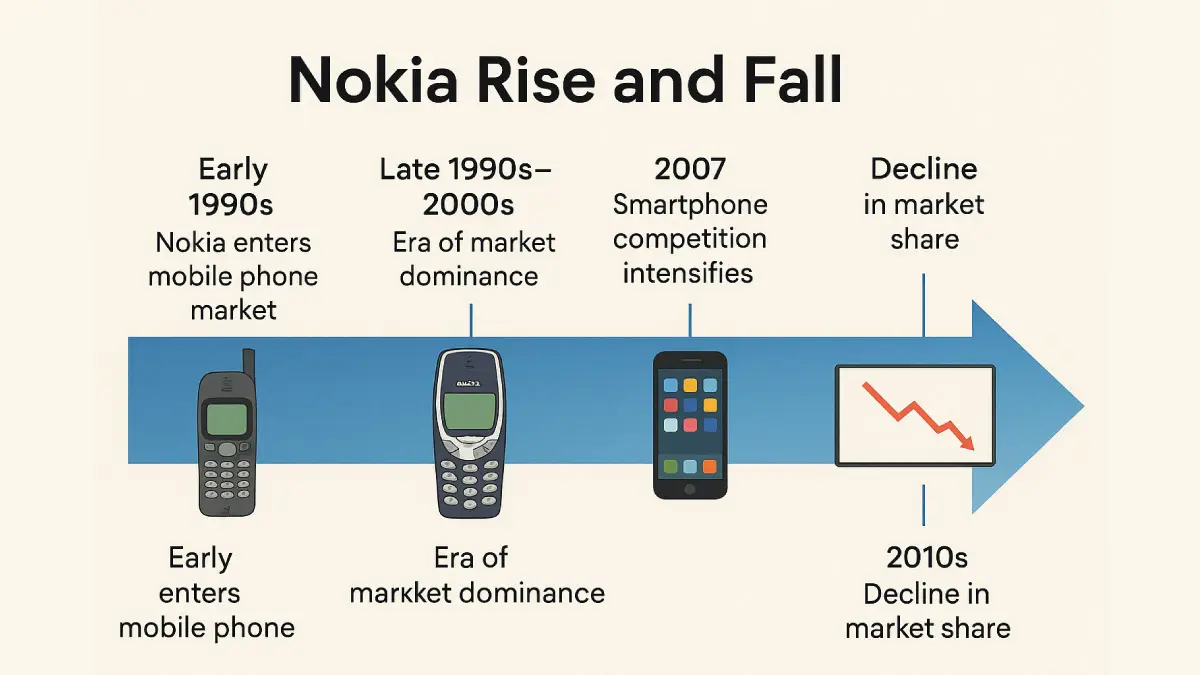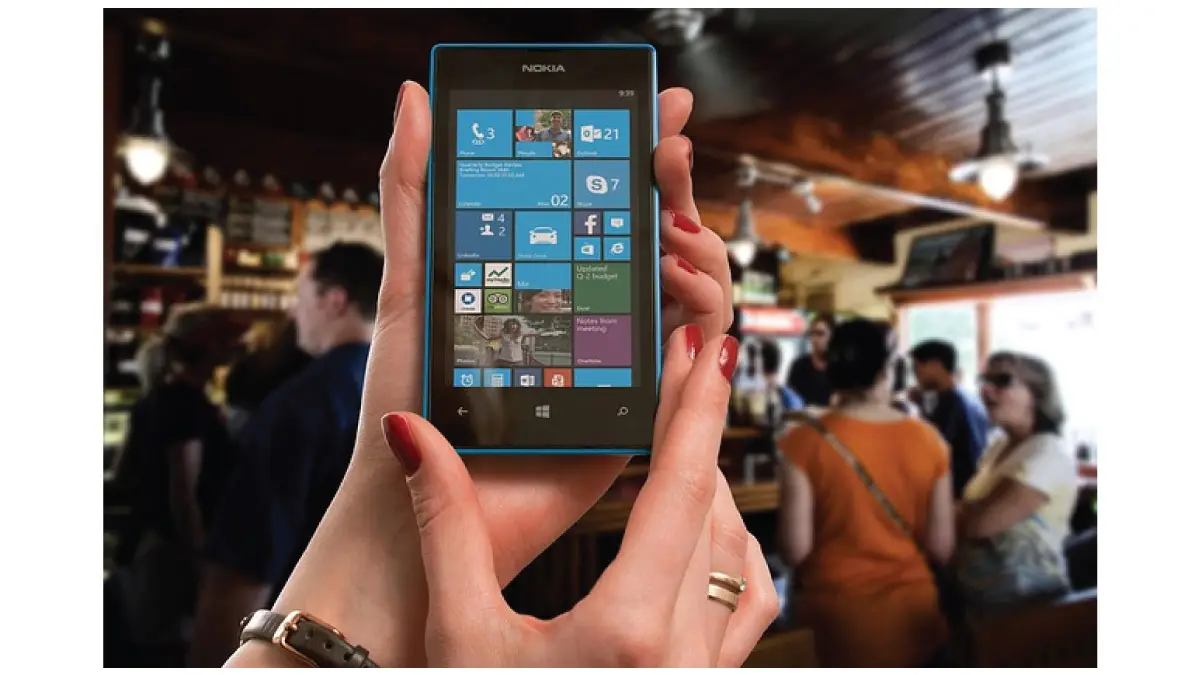
Nokia’s rise and fall in the mobile phone industry is more than a history lesson—it’s a treasure trove of insights for tech enthusiasts, business leaders, and anyone keen on avoiding the pitfalls of complacency. At its peak, Nokia commanded over 40% of the global mobile phone market and was virtually synonymous with mobile innovation. Yet in a stunning reversal, it took only about six years for Nokia to lose roughly 90% of its market value following the smartphone revolution. How could a company so dominant fall so hard and fast? As tech specialists at Esmond Service Centre with decades of industry experience in Singapore, we witnessed Nokia’s rise and fall firsthand. In this article, we leverage our expertise to dissect the key reasons behind Nokia’s downfall and, more importantly, provide step-by-step guidance on how to learn from Nokia’s story. By understanding what fueled Nokia’s early success and what went wrong later, you’ll gain valuable lessons to drive innovation, steer clear of similar mistakes, and stay ahead in today’s ever-evolving tech landscape.
Nokia’s early success was no accident—it was the product of visionary leadership and bold innovation. In the 1990s, Nokia bet big on mobile communications, shifting from rubber and cables to focus on cell phones and telecom networks. This gamble paid off as Nokia’s innovative devices (like the iconic Nokia 3210/3310 series) and efficient supply chain propelled it to the top of the mobile phone market by the late 1990s. However, this very success planted the seeds of complacency. Over time, success bred conservatism and hubris in Nokia’s culture. Management grew confident that what had worked so well before would keep working, and they underestimated the need for continual change. Nokia was under the impression that it did not need to improve itself or launch new products more frequently, a mindset which allowed rivals like Apple and Samsung to gain an edge.
Solution & Why it Works: Never let early success lull your company into stagnation. To avoid Nokia’s fate, businesses must foster a culture of continuous innovation. This means regularly investing in R&D, encouraging creative ideas, and periodically re-evaluating product strategy even when you’re at the top. By doing so, you keep complacency at bay and ensure your offerings evolve with—or ahead of—consumer expectations. This approach works because in technology, standing still means falling behind; constant innovation keeps a company relevant and resilient against up-and-coming competitors.
If Nokia’s rise was meteoric, its fall was precipitated by a single paradigm shift: the advent of the modern smartphone. When Apple introduced the iPhone in 2007 and Google’s Android emerged soon after, Nokia was caught flat-footed. The company clung to its existing platform (Symbian OS) and was initially skeptical about touchscreens and app-centric ecosystems. By 2009, even Nokia’s executives acknowledged they had been “slow to react to the rise of new devices such as the iPhone,” a delay that led to the company’s first quarterly loss in over a decade. Nokia’s once-dominant global smartphone market share (over 50% in 2007) plummeted to just 3% by mid-2013. Why? Nokia underestimated how quickly consumers would embrace the iPhone’s sleek touch interface and the Android platform’s open app ecosystem. The company’s own touchscreen and software efforts (like the Nokia N97 and the MeeGo OS) were too little, too late. When new CEO Stephen Elop took the helm in 2010, he famously likened Nokia’s situation to a man standing on a “burning platform,” underscoring the dire need to change course. Solution & Why it Works: Embrace disruptive trends early and decisively. In practice, this means keeping a pulse on emerging technologies and being willing to pivot your business model when the landscape shifts. Had Nokia pivoted to a modern smartphone OS sooner (for instance, adopting Android or accelerating its own software development), it might have preserved its lead. The reason this solution works is simple: in fast-moving industries, early adopters set the pace. Companies that proactively adapt to new paradigms—be it touch-based smartphones, AI integration, or any game-changing innovation—position themselves as market leaders rather than followers. By contrast, those who delay risk becoming obsolete virtually overnight in the face of agile competitors.
Another key factor in the Nokia rise and fall story was the shift from a hardware-centric view of the world to a software-centric one. During Nokia’s glory days, a phone’s success was largely about solid hardware, reliable basic software, and brand reputation. But the iPhone and Android revolution proved that software ecosystems (app stores, developer communities, and user-friendly operating systems) were the future of mobile technology. Nokia failed to recognize just how crucial this was.
The Symbian OS that powered Nokia’s early smartphones became outdated—by 2010 it was painfully clear that Symbian’s design (built for keypads and simple apps) couldn’t compete in a world of touch-driven, app-intensive smartphones. Yet Nokia stuck with Symbian far too long and then made a fateful strategic move: partnering with Microsoft in 2011 to use Windows Phone on Nokia devices. Unfortunately, Windows Phone, while smooth, had a tiny app ecosystem and never gained significant market share. Nokia even declined to switch to Android when it had the chance, partly due to fear of directly competing against Samsung on Google’s platform. This left Nokia without a compelling software ecosystem of its own. As industry insiders noted, Nokia was trapped in a “device-centric system in what was becoming a platform- and application-centric world”, and it lacked the skills or mindset to fully engage with the new app-driven model.
Prioritize software innovation and build ecosystems around your products. For modern tech companies, this might involve creating a robust API for developers, cultivating third-party integrations, or investing in user experience design as much as in hardware. The reason this strategy succeeds is evident in the Nokia case—today’s consumers are drawn to products that offer a rich ecosystem of apps and services. A phone (or any device) is only as good as the software and experiences it enables. Companies that cultivate thriving ecosystems (like Apple’s App Store or the Android Google Play ecosystem) lock in user loyalty and attract partners, creating a network effect. By focusing on software quality, user interface, and third-party developer support, you ensure your product isn’t just a one-time purchase but part of a broader experience that users will stick with.
Behind the scenes of Nokia’s rise and fall were deep organizational issues. As Nokia grew into a global giant, its once-agile structure swelled into a complex matrix of divisions and departments. By the mid-2000s, the company’s structure had become bureaucratic and siloed, with internal factions sometimes working at cross purposes. Former Nokia executives and analysts often describe how destructive internal competition and a “not invented here” mentality took hold, hampering cooperation. For example, teams developing Nokia’s new software platforms allegedly faced resistance or lack of urgency from other departments, leading to delayed product launches and missed opportunities.
A case in point: Nokia was juggling multiple smartphone projects (Symbian updates, MeeGo, etc.) without a unified vision, resulting in 57 different (and incompatible) software versions across its phones by 2009. This kind of fragmentation made innovation sluggish. As one analysis noted, “Once the competition got fiercer, Nokia began to crumble from the inside. Different departments stopped coordinating and began competing – and customer experiences suffered because of it.”Furthermore, top management became disconnected; as the tech landscape evolved, many Nokia leaders lacked the software savvy to make quick, bold decisions, and middle managers were often too fearful or constrained to push critical feedback upward.
Build an agile, open organization with clear communication channels. Companies must foster collaboration rather than competition among teams. Practical steps include adopting cross-functional project teams, streamlining management layers, and encouraging a culture where employees can voice concerns or ideas without fear (“don’t shoot the messenger” is key). Nokia’s downfall shows that even the best strategy can falter if internal execution is poor. By contrast, an agile organization—where information flows freely and decisions can be made quickly—can respond to market changes in real time. This works because when all departments are aligned toward common goals (rather than internal turf wars), the company can innovate faster, address problems sooner, and deliver consistent quality to customers. In essence, ensuring your organizational structure and culture support your strategy is just as important as the strategy itself.

Even as Nokia grappled with technology transitions, it also stumbled in marketing and brand strategy during its fall. In the early 2000s, Nokia was a household name associated with durable, user-friendly phones. However, the company’s branding became muddled in the smartphone era. Nokia introduced a flurry of new model lines—N-series, E-series, Lumia, Asha, etc.—often with confusing naming conventions and unclear positioning. Consumers who once found Nokia phones straightforward now faced a maze of choices. Analysts point out that Nokia’s marketing strategy failed in that it frequently launched entirely new model lines (with new names) instead of building a cohesive “umbrella” brand around a flagship. Meanwhile, competitors kept things simple: Apple had the iPhone (with sequential models), Samsung had its Galaxy series—easy for customers to follow. Moreover, Nokia’s presence in critical markets like North America weakened due to insufficient carrier partnerships and less aggressive marketing, ceding those spaces to Apple and Android OEMs. Compare Nokia’s approach to its rivals: Apple and Samsung rolled out yearly flagship launches with huge fanfare, generating anticipation and buzz with each iteration. Nokia, in contrast, often appeared one step behind, with marketing that failed to excite the emerging smartphone consumer base.
Solution & Why it Works: Craft a clear, consumer-centric marketing strategy and stick to a strong brand narrative. This means simplifying your product lineup so customers understand your flagship offerings and their advantages. It also means investing in marketing campaigns that highlight your unique value and keep your brand in the public conversation. Consistency is key: for instance, if Nokia had unified its smartphones under one strong brand name (as it did in the past with the “Nokia” name itself signifying reliability), it could have leveraged existing brand loyalty instead of diluting it.
The efficacy of this solution is evident in today’s market—companies with focused branding and messaging (like Apple’s singular iPhone branding, or Samsung’s Galaxy) create stronger identity and loyalty. Coupling this with active engagement of consumer feedback—through social media, surveys, user communities—ensures that you stay attuned to what your customers want. In short, a great product isn’t enough; you must also communicate its greatness effectively. By learning from Nokia’s marketing missteps, modern companies can ensure they not only make outstanding innovations but also win the hearts and minds of their target audience.
Enjoyed this comprehensive analysis?Follow our FaceBook page, Linkedin profile or Instagram account for more expert insights and practical tips on cutting-edge technology. And remember, the team at Esmond Service Centre is here to help – if you’re looking for professional consultation or tailored advice for your business’s tech strategy, contact Esmond Service Centre today for expert guidance. We’ve helped countless clients navigate the fast-changing tech landscape, and we can help you innovate confidently without repeating the mistakes of even the biggest industry giants.

Reviewed and originally published by Esmond Service Centre on July 1, 2025
Mon to Fri : 10:00am - 7:00pm
Sat : 10:00am - 3:00pm
Closed on Sunday and PH